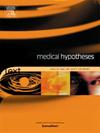内源性酒精转化为去甲肾上腺素和肾上腺素可能有助于宿醉
IF 2.1
4区 医学
Q3 MEDICINE, RESEARCH & EXPERIMENTAL
引用次数: 0
摘要
一些理论出版物表明,可能存在一种或多种新的生物合成途径,将酒精(乙醇)转化为儿茶酚胺能神经递质多巴胺、去甲肾上腺素(NE)和肾上腺素(EPI)。最近一项在小鼠身上进行的高分辨率质谱研究发现,乙醇确实以一种分子选择性的方式促进了海马NE,在这种方式下,NE可以转化为EPI。目前的出版物提出了一个新的但相关的假设:乙醇促进NE和EPI可能在酒精相关的宿醉(AH)中起重要作用。AH的令人厌恶的症状,如疲劳、头痛、口干、恶心、血压升高、出汗、对光和声音敏感、焦虑、易怒、脱水和睡眠中断,都可能部分与大脑和外周的NE和EPI升高有关。其中一些症状以前与去甲肾上腺素能或肾上腺素能信号有关。如果乙醇转化为这两种儿茶酚胺确实是AH的一个重要因素,那么降低去甲肾上腺素能传递的药物,如可乐定、胍法辛、心得安和哌唑嗪,可能对这种情况有治疗作用。最后,如果过量饮酒可通过急性生物合成导致NE和EPI水平达到危险的高水平,这可能在酒精中毒及其潜在的致命性中发挥作用。本文章由计算机程序翻译,如有差异,请以英文原文为准。
Endogenous conversion of alcohol to norepinephrine and epinephrine may contribute to hangover
Several theoretical publications have suggested that there may be a novel biosynthetic pathway or pathways that transform alcohol (ethanol) into the catecholaminergic neurotransmitters dopamine, norepinephrine (NE), and epinephrine (EPI). A recent empirical, high-resolution mass spectrometry study in mice found that ethanol indeed boosts hippocampal NE in a molecularly selective manner, where such NE could be converted to EPI. The current publication puts forth a new but related hypothesis: boosting of NE and EPI by ethanol may play an important role in the alcohol-related hangover (AH). Aversive symptoms of AH such as fatigue, headache, dry mouth, nausea, elevated blood pressure, sweating, sensitivity to light and sound, anxiety, irritability, dehydration, and disrupted sleep, may all be partially related to elevated NE and EPI, both in the brain and in the periphery. Some of these symptoms have previously been associated with noradrenergic or adrenergic signaling. If conversion of ethanol to these two catecholamines really is a prominent factor in AH, then noradrenergic transmission reducing drugs such as clonidine, guanfacine, propranolol, and prazosin may have therapeutic properties in this condition. Lastly, if consumption of excessive amounts of alcohol can result in dangerously high levels of NE and EPI through acute biosynthesis, this could play a role in alcohol poisoning and its potential lethality.
求助全文
通过发布文献求助,成功后即可免费获取论文全文。
去求助
来源期刊

Medical hypotheses
医学-医学:研究与实验
CiteScore
10.60
自引率
2.10%
发文量
167
审稿时长
60 days
期刊介绍:
Medical Hypotheses is a forum for ideas in medicine and related biomedical sciences. It will publish interesting and important theoretical papers that foster the diversity and debate upon which the scientific process thrives. The Aims and Scope of Medical Hypotheses are no different now from what was proposed by the founder of the journal, the late Dr David Horrobin. In his introduction to the first issue of the Journal, he asks ''what sorts of papers will be published in Medical Hypotheses? and goes on to answer ''Medical Hypotheses will publish papers which describe theories, ideas which have a great deal of observational support and some hypotheses where experimental support is yet fragmentary''. (Horrobin DF, 1975 Ideas in Biomedical Science: Reasons for the foundation of Medical Hypotheses. Medical Hypotheses Volume 1, Issue 1, January-February 1975, Pages 1-2.). Medical Hypotheses was therefore launched, and still exists today, to give novel, radical new ideas and speculations in medicine open-minded consideration, opening the field to radical hypotheses which would be rejected by most conventional journals. Papers in Medical Hypotheses take a standard scientific form in terms of style, structure and referencing. The journal therefore constitutes a bridge between cutting-edge theory and the mainstream of medical and scientific communication, which ideas must eventually enter if they are to be critiqued and tested against observations.
 求助内容:
求助内容: 应助结果提醒方式:
应助结果提醒方式:


